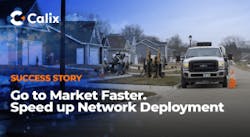Are Legacy Systems Impeding 5G Rollouts?
Data Lag Is No Longer Acceptable —
The FCC recently launched a 5G Fast Plan for nationwide coverage, challenging the private sector to meet this ambition. The Pentagon also recently agreed to share part of the wireless spectrum to help speed up telecom operator rollout in remote rural regions with fewer call towers. However, the rollout has been slower than anticipated, with US 5G coverage lagging behind countries such as South Korea and China. Not only is coverage patchy, but 5G network speeds also vary widely from place to place.
The stakes are high, with research estimating that $13.2 trillion in global economic value will be made possible by 5G in 2035, which will in turn widen the economic gap between early and late adopters. 5G will be fundamental to everything from industrial automation, dense area services, and disaster response, to autonomous transport, smart grids, and massive content streaming services.
5G is as vital an enabler to the Fourth Industrial Revolution as electricity networks were to the Second Industrial Revolution — which means ensuring comprehensive coverage is now essential. As the post-lockdown economy is reshaped around remote working, this will also produce a greater need for faster in-building connectivity in homes as well as businesses. Ensuring equality of coverage nationwide will be vital to both achieving regional economic equality and expanding the market for telecom operators.
The Legacy Lag
As millimeter waves are short-range and spread out, networks need to be completely redesigned to achieve the required density and range to direct the frequencies at target populations. The small range of the antennae used for beamforming means that achieving full coverage requires many antennae strategically positioned on rooftops, parks, and commercial buildings, to avoid signal interference. Creating complementary networks of antennae capable of reaching the maximum number of households and businesses at the lowest cost is a major logistical challenge.
Equality of access requires a cost-effective way of ensuring the widest possible coverage at the lowest cost and risk to reach both urban and remote rural populations. Millions of antennae need to be optimally positioned to reach the widest market while avoiding signal obstruction or weather hazards.
This is rendered even more difficult because the geospatial systems used to map telecoms grids are already struggling to keep pace with fiber deployments, and will be pushed even further to manage the scale of changes needed to deliver ambitious 5G targets. Complex network assets such as 5G antennae are often still represented in a non-interactive 2D format, which means they are often inaccurate or out-of-date. All too often, many operators are still using paper maps. These network maps can be maintained only by specialist cartographers, and are therefore not regularly updated with new information from field workers or digital sensors.
It’s not unusual to take weeks or months for network field changes to be reflected in a GIS database. One large operator we talked to recently explained that they have around 50,000 jobs in their GIS "as-built update" queue while others have reported as many as 50% of as-builts are incorrect.
The Data Gap
The consequences are that many operators do not know the location of present and planned networks in relation to all the population centers and services with the poorest signal. The disconnect between data in the field and in the office only increases as telecom grids are now being rapidly expanded and upgraded to extend 5G coverage. A process model based around physical maps and siloed applications cannot fulfill the operational requirements of a telecom company that needs rich, real-time data to meet the complex and costly challenge of nationwide coverage.
InvisiLight® Solution for Deploying Fiber
April 2, 2022Go to Market Faster. Speed up Network Deployment
April 2, 2022Episode 10: Fiber Optic Closure Specs Explained…
April 1, 2022Food for Thought from Our 2022 ICT Visionaries
April 1, 2022Operators cannot plan the optimal locations for new antennae without a comprehensive and current "stock-take" of all existing assets in relation to potential consumer and business customers. Without accurate data on as-builts, they cannot model the risk from nearby hazards such as signal interference from neighboring buildings or street furniture. Smart telecoms grids are also impossible without the ability to integrate and analyze live data from the field for predictive maintenance, disaster resilience, and smarter customer service.
Pioneering US operators such as TELUS are now replacing centralized, siloed network GIS data with a decentralized geospatial network view that draw on data from any sensors, web browsers, or employee devices in the field. Over time, field-sourcing geospatial network data enables companies to significantly reduce the number of updates that require a GIS specialist. This allows GIS data to be quickly scaled up to match 5G network growth ambitions.
Technologically progressive operators are abolishing paper maps in favor of digital GIS with applications that can run online or offline so that they are always available.
Rather than being splintered into siloed applications, data can be integrated from across the enterprise to create a holistic overview of dispersed network assets. This means networks are easily accessible and amendable from the office to the field, and changes can be clearly visualized. With accurate location data, each antenna could be strategically placed to achieve the optimal range and beamforming in every location.
Data-Driven Decisions
This digital geospatial strategy fosters a data-driven approach to modelling future needs, maximizing ROI while minimizing the cost and risk of new infrastructure investment. For example, a company could even incorporate internal geospatial data and local tax data to find the lowest cost locations for new antennae. Planned telecom infrastructure can be accurately mapped and merged with data on neighboring hazards so antennae can be optimally positioned to avoid obstruction from tall buildings or lamp posts. Planned networks could be merged with local ecological or meteorological data to model the impact of tree foliage or rain on signal strength in each location.
Employees could use smartphone apps to quickly update network maps with new information including damage from extreme weather events affecting network assets such as Winter Storm Uri in Texas. In the future, these systems could create predictive telecom grids that can autonomously anticipate repairs, upgrades, or even forecast the need for new infrastructure years in advance.
Cumulatively, this would enable 5G networks to be extended to deliver more consistent and comprehensive coverage by creating smarter, more joined-up network planning. Ultimately, we could see current network GIS replaced by multi-layered digital twins merging everything from local ecological to economic features to help visualize and maximize the target market for each new antenna.
Linking regional networks on a national level could also help to drive holistic planning of future networks, ensuring complementary coexistence with neighboring infrastructure to achieve nationwide coverage and maximize ROI.
The true key to nationwide 5G lies in having modern geospatial technology that can visualize the web of interdependencies between networks, people, and infrastructure, in order to realize the ultimate potential of a ubiquitous 5G network.
https://www.wired.com/story/white-house-plan-speed-rollout-5g/
https://www.wired.com/story/slow-rollout-super-fast-5g/
http://www3.weforum.org/docs/WEF_The_Impact_of_5G_Report.pdf
https://techgenix.com/5g-rollout/
https://www.fiercetelecom.com/telecom/at-t-verizon-special-offers-provide-some-winter-storm-relief
For more information, please visit https://www.iqgeo.com.
Follow us on Twitter @IQGeo_software.




